Campfire Cooking Tips.
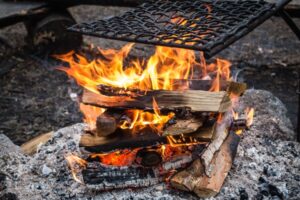
Placing items in the fire for cooking and removing them can be tricky around the camp fire.
The heat and the open flames can make cooking hard, with things like stirring the meals and moving cooking utensils on and off the fire.
It can also be a safety concern around cooking on the campfire.
So in this article we cover some campfire cooking tips to make life easier. Such as options on how to place cooking utensils on the fire and remove them easily. Also we will look at items that will make it safer around the campfire.
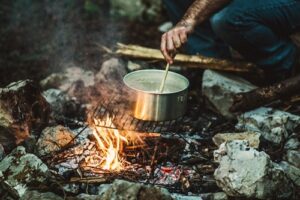
Here are some campfire cooking tips.
Small controlled fire.
One easy way to control the cooking temperature of the campfire is to have the fire smaller. For general cooking, you don’t need a huge bonfire.
A smaller campfire is easier to control cooking the food and safer. A large fire will just burn the food and because of the heat, the meal will be checked and stirred less.
It is easier to put some kindling and wood on the fire to increase the heat for cooking, rather than if the fire is too big. As you have to wait for it too cool down before you can cook.
Windbreaker.
Pay attention to the direction of the wind as well. You might make a wind break (Some people might call it a fire reflector.) to protect the campfire and stop the smoke going everywhere.
Smoke does seem to follow you around the campfire, so a windbreaker, or even two sides sheltered might make cooking easier.
Don’t use flammable materials for the reflector. Use green wood materials, or rocks, etc.
Remember though the green wood will eventually dry out and be likely to catch on fire. If you are camping for a while, some mud on the green wood windbreaker, might work to protect it from the heat.
Have enough wood for the fire.
To save rushing around collecting kindling and wood and trying to cook a meal on the fire all at once, collect the wood earlier on.
Have spare wood available, there is nothing worse than cooking a meal and you have to try and get more fire wood while watching and stirring the meal.
If it is cold, you might need more fuel than normal.
Get the campfire ready early.
An important cooking tip is to light the campfire early. Depending on the size of the fire and wood type, you might have to light it about one hour before you even to start to cook.
The fire does take a bit of time to burn down into some nice coals.
Cook on the coals.
Which leads me to my next point, cook with the coals, not the flames.
Flames are very hard to cook with. As the heat and height of them can be unpredictable as the wind can blow them all over the place.
Hot coals and white coals can also be manipulated and moved around the fire easier, then a burning big log.
I have mentioned it before in other camping cooking articles, but coals for cooking and flames for boiling water is the mantra.
If it is safe to do so, don’t be afraid to move the coals a little bit away to the side of the main fire, so when you attend the food, you don’t get too hot near the main fire.
Campfire cooking equipment.
Have a shovel.
A shovel around campsite is very handy. Like for trying to get bogged vehicles out, preparing the toilet spot, but where it really shines is for cooking.
You can dig the fire pit, move burning bits of wood around, and shovel coals to the side for a nice bed of coals for cooking on.
For a Dutch oven or cast iron camp oven, the shovel can scoop the coals up and place then around and on the camp oven.
A long handled shovel or spade makes it easier to move hot items around when cooking.
With wider cooking based utensils directly on the fire, like a skillet, fry-pan or small cast iron camp oven, a shovel is handy for gently scooping under in the fire and removing it.
A shovel can also help put a fire out with sand or dirt or used to help smother it.
If a long handled shovel or spade is not available, even a foldable or small shovel is good around camp.
Leatherman Tool.
A multi-tool, pair of pliers, or a Leatherman tool is great for around camp and have one hundred and one uses.
The pliers can be used to remove a hot from the fire. As an example if you are placing a can of baked beans directly on the fire (No dishes.) to heat it up, the pliers can be used to help get it off the fire.
They can also hold the tin, container or pot when stirring the food.
One tip when stirring pots, pans, cooking utensils on the camp fire is; it is generally easier to take the item off the fire, then stir it, then place it back on the coals.
Otherwise it can get to hot trying to stir the pot, while it is on the fire.
Gloves and bandana.
An old piece of cloth or a bandanna is handy for getting items off the campfire or holding them.
You can also use the cloth to wipe up or clean the cooking mess.
A pair or sturdy leather gloves can also help remove hot items and is a good way of protecting your hands.
The gloves can also be used for when collecting firewood.
Long Spork.
For a personal eating utensil, try and get a longer handled camping fork, spoon, spork or splade. This makes eating from a tin, billy pot, cups / canteen a lot easier.
For stirring dehydrated and freeze dried meals, and trying to get the last morsel of food at the bottom corner of the pack, a long handled utensil is easier and less messy.
As with a short handled spoon you have to nearly put your hand in the pack to scoop the food.
Long handled cooking utensils.
For the campfire or a BBQ, long handled tongs, spatula and forks make it safer and easier to turn, remove and stir food on the heat.
A stick for stirring?
If you forget the long handled cooking spoon or tongs, don’t despair. A clean stick can be used for stirring your food. The advantage is you can get a long stick that you can stir the food without getting to close to the fires heat.
Ideally don’t use a stick lying on the ground, as you don’t know what has walked over it, such as a deer with scat on its hoofs.
Preferably use a green wood, so it doesn’t burn easy. Make sure it isn’t a toxic wood and it is clean.
I sometimes strip the bark of the stick and put it briefly in the flames to make it a bit more hygienic and kill the germs.
One danger of using one stick for stirring as an example is, stirring a can of baked beans on the fire. It is easy to knock the can over. So you can use two sticks to help move it off the fire.
You can also place one stick inside the can too hold the container steady and the other stick too stir the food.
It takes a little bit of skill not to knock the tin in the fire, but it can work if you are slow and steady.
Fish mouth spreader bottle hanger.
A wire hangar or a fish mouth spreader is ideal for lifting items like a stainless steel water bottle from the fire with.
The spreader is placed inside the bottle shoulder / lip and you can insert a stick into the spreader to lift it. Such as a wide mouthed single walled Klean Kanteen bottle.
Alternatively you can hang the spreader from some cordage or stick from a tripod or pot crane. For cordage, it keeps the cord a bit further away from the heat and flame, so hopefully it won’t burn.
This fish mouth spreader can also be used for nesting cups like the Pathfinder stainless steel brand.
If a nesting metal cup hasn’t got any holes in it, you can drill holes in it the top.
Also you can make a bail handle from wire to attach to it permanently.
Nesting cups and Billy pots.
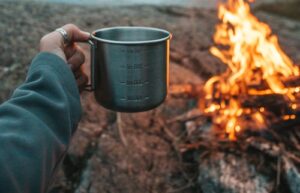
Butterfly handles or bat-wing handles on Billy cans and nesting metal cups are a good way to hold items. Nesting cups and cooking items without the handles are harder to hold and maneuver on the fire.
British mess tins with long handles are also another cooking utensil that is handy. Backpackers and campers might find a set useful for cooking food in.
Long handled fry pans.
If you don’t have a long handle skillet or fry pan, you can lengthen the handle. Use a green stick and some wire, so the longer handle is easier to get out of the fire. Wrap the wire around the stick and handle to secure it.
Ways to hang the cooking pots.
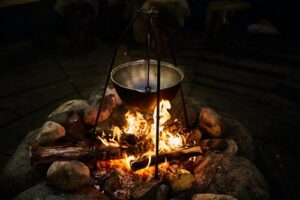
No we have looked at some camping gear to help you with camp cooking, here are some ways to hang your cooking utensils off the fire.
Whether it is for boiling up some water in the billy can for a coffee or you are cooking a hearty stew in a pot.
Small chain.
While probably a bit heavy for backpackers, a small chain can be useful for car campers for hanging cooking utensils over the fire.
If the chain has a “S” or “J” hook, it can also retrieving items directly laying on the coals, if the pot or camp oven has a handle on it.
Pot crane.
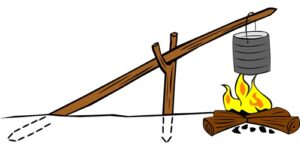
There are dozens of ways you can set up a pot crane. While it takes a bit longer to craft a pot crane they are great for hanging a billy can off it.
Some ways you can swivel it on and off the fire, some you can raise and lower for cooking height. Here are some variations of the pot crane for cooking.
A pot crane can be swiveled on and off the fire hanger
You can stick the pot crane in the ground and put a rock over it so the weight of the billy tin doesn’t tip it over.
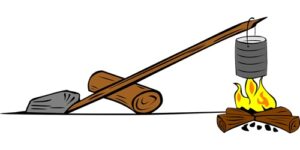
Tripod.
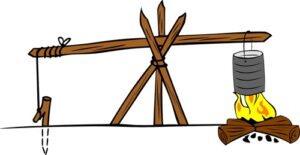
A tripod is another good way to hang the billy pot over the fire.
You can position the legs of the tripod out or in, to raise or lower the pot over the fire.
Or use a wood pot hanger with notches in it to adjust the pot hanger and raise or lower the billy pot.
You might have cordage for the top section of the hangar and the lower section some green stick with notches in it to hold the billy can. (The cordage may burn, so only use for the top part.)
You can also use two tripods either side of the fire and a main ridgepole horizontally supported by the two tripods.
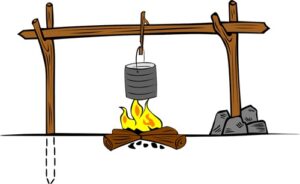
Or two “Y” sticks put in the ground with a ridgepole supported between them. Or use rocks to support the “Y” sticks.
Other cooking methods.
Sometimes cooking from the open flames can take a bit of planning. So you can still have a campfire for warmth, but you might chose to cook with a different method. Such as a spirit stove, canister backpacking stove, hexamine stove, etc.
Visit, Ways to Cook While Camping for more information.
Or maybe you are cooking one item in the campfire, such as baked potatoes, but you are cooking a steak on a portable gas stove.
What to cook on the campfire? Click on Ideas For Camping Meals for some recipes to cook.
Campfire cooking safety.
Of course use common sense and don’t have the fire bigger then needed when cooking. As it just takes more fuel and becomes a safety concern when too big.
Follow your areas fire regulations and have water handy to put the fire out properly when finished. Triple check the campfire is out when leaving and smother it with water.
Summary – Camping cooking tips.
I hope some of these campfire cooking tips, on cooking equipment and techniques and ways to safely remove items from the fire are useful.
I don’t know about you, but food cooked on the campfire tastes a lot better than home cooked food, even the simple can of baked beans tastes five star.
